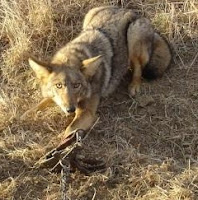 Fur coats and products with fur trim are the result of a brutal and violent industry. Each year, millions of animals are killed for their pelts. In Canada, approximately one million animals are still trapped for their fur each and every year. Of the animals trapped, almost 90% are victims of leg-hold traps.
Fur coats and products with fur trim are the result of a brutal and violent industry. Each year, millions of animals are killed for their pelts. In Canada, approximately one million animals are still trapped for their fur each and every year. Of the animals trapped, almost 90% are victims of leg-hold traps.What does a leg-hold trap feel like? Imagine slamming a car door on your fingers and you'll have a pretty good idea. But as painful as the traps are, they aren't designed to kill. They simply hold the animal until the trapper returns to finish her off, which could amount to days of insufferable agony.
Some 'accepted' methods of killing trapped animals include clubbing, suffocation and drowning. In addition to the targeted animals, countless others become trapped as well. These include family pets, endangered birds and in 2002, a 13-year-old B.C. boy, who received injuries to his leg after getting caught in a beaver trap not far from his home.
In 1996, an Angus Reid Poll found that 80% of Canadians oppose the use of leg hold traps. Sadly, leg hold traps are still the ‘trap of choice’ in Canada today.
However, most fur today comes from fur farms - also known as fur ‘ranches’. Here the animals suffer even worse, forced to endure confinement in tiny wire cages with barely enough room to turn around. Deprived of basic necessities like clean water, protection from harsh weather and exercise, many animals develop neurotic behaviours including depression, repetitive movements and self-mutilation.
Some animals are also subjected to genetic experimentation and inbreeding to produce specific colours, leaving many animals with crippling deformities and conditions such as blindness, neck spasms, painfully contracted uteruses, and susceptibility to disease. Fur farms are designed to maximize output, with no regard for the animals' mental, emotional, or physical well-being.
Surprisingly, there are no laws dictating how these animals are to be killed. The least expensive way is usually the most appealing. Some methods include carbon monoxide poisoning which burns the eyes and lungs of the victim; strychnine poisoning (which causes painful muscle cramps leading to suffocation); anal or vaginal electrocution, (which can last for up to 20 seconds because the current does not pass through the brain); suffocation by crushing the chest, and neck-breaking. All of the above methods are perfectly legal and standard practice in the fur industry.
Recently, attention has been drawn to the over 2 million dogs and cats that are slaughtered each year around the world - mainly from China, Thailand and the Philippines - to provide fur and fur trim for clothing, accessories and toys (for both children and pets).
Many countries have banned the import and sale of dog and cat fur, including Italy, France, Australia, and in 2002, the United States. Unfortunately, it is legal to import dog and cat fur into Canada and there are currently no standards in this country to distinguish real fur from fake fur on clothing labels.
How You Can Help
1) Don't buy items made of fur and fur trim. And don’t be fooled by fur that looks synthetic. A fur coat, hat or lining dyed pink or purple may still be real fur. Make sure it’s fake before buying it.
2) If you know of a store that sells fur or products made of fur, tell the manager or store owner (or write them a letter) that you will only shop there if they stop.
3) Write a letter to the editor of your local newspaper to let the public know how you feel about fur products.
4) Urge the Prime Minister to ban all imports of dog and cat fur to Canada. You can send your letter to:
The Right Honourable Stephen Harper
Office of the Prime Minister
80 Wellington Street.
Ottawa, ON
Canada
K1A 0A2
Fax: (613) 941- 6900
Email: pm@pm.gc.ca
“You can judge a nation, and its moral progress, by the way it treats its animals.” - Mohandas K. Gandhi

1 comment:
I just visited a website www.niagaraanimalrightscenter.blogspot.com It states that Canada allows the importing of fur from dogs and cats from China. If this is true, this practice has to be stopped! I'm sure that if people of our nation were aware that they were purchasing fur derived from animals that we consider pets, the sales would decline steeply. I for one, would never buy an article of clothing made from dog or a cat, an animal I consider to be friends of humankind.
David K. Hicks
Post a Comment